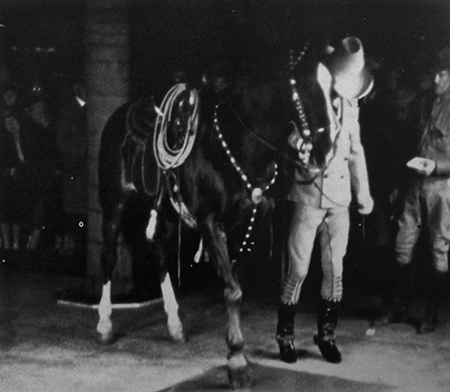 |
 |
|
|
| Tom Mix & Tony the Wonder Horse |
 |
| Forecourt Ceremony held on Monday, December 12, 1927 |
| |
Born: Thomas Hezikiah Mix, January 6, 1880, in Mix Run, Pennsylvania
Age at the time of the ceremony: 47
Died: October 12, 1940, in Florence, Arizona, age 60
Born: Tony the Wonder Horse, in 1909, probably in Los Angeles, California
Age at the time of the ceremony: 18
Died: October 12, 1942, in Los Angeles, California, age 31 |
| |
Tom Mix was the first cowboy movie star. Entering into films before William S. Hart, in 1909, Mix made a huge number of silent short films, which helped spread the Gospel of the movies throughout America. Mix defined the image of the American cowboy to the rest of the world.
Tom's colorful life began in a small town in central Pennslyvania, where his father worked as a groomsman for a local lumber baron. Mix's father taught him to ride and care for critters. Tom early on wanted to become a circus performer. When the Spanish-American War came along, Mix enlisted in the Army, but was later found AWOL in order to get married to his first wife (he would be married five times).
Mix worked as a cowboy at the Miller Brothers 101 Ranch, joining their Wild West Show, where he showed off his riding, roping and shooting skills. In 1909, Mix joined with the Selig Polyscope Company in Los Angeles, where he was to star in his own short films almost immediately. 100 films later, the Selig studio was struggling, so Mix made a deal to make pictures for William Fox in 1917.
Tony the Wonder Horse had been trained by Pat Chrisman from 1914. Mix bought Tony in 1917 for $600. The first film they made together was Cupid's Round Up for Fox (released in January 1918). Chrisman continued to work with Tony, who could sometimes "just not feel like working that day." Mix would occasionally treat his horse to the sounds of a brass band, claiming that Tony liked the sound. Just as with any on-camera performer, Tony had his own stunt doubles, who did the really dangerous shots.
The Mix films, which grew longer as the feature film became more popular during the 1920s, were simple stories, where the hero gets the girl in the end and all the bad guys are dead or in jail. Mix performed many fantastic stunts and wore flashier clothes than what was historical, even though he did employ Wyatt Earp as a technical advisor. The Fox films had titles like Durand of the Badlands (released in August 1917), Hell Roarin' Reform (released in February 1919), Big Town Round-Up (released in June 1921), the second adaptation of Riders of the Purple Sage (released in March 1925), and The Great K &A Train Robbery (released in October 1926), which features some great stuntwork with the title train).
After
his Forecourt ceremony, Mix began a stint with Joseph Kenndy's Film Booking Offices (FBO) in 1928, but went on record saying that Kennedy was a "tight-assed, money crazy son-of-a-bitch." He went to work for Universal, breaking into talkies fair enough, but like many people from the early days, making sound films wasn't as much fun, but there was another problem.
By this time, Tony eventually couldn't work on set as well as he had, so Mix reluctantly put him out to pasture in 1933. Tony Jr. was used from then on. Mix's final screen role was in a serial called The Miracle Rider (released in April 1935). Mix returned to circus performing with his daughter Ruth, but they had a falling out over — what else? —money. He performed on his own radio program sponsorerd by Ralston-Purina called Tom Mix Ralston Straight Shooters, which was continued after Mix's death from an auto crash in 1940. Mix was only 60. |
|
|
|
|
| |
 |
 |
| Grauman's Chinese Theatre, Hollywood, California. Tom Mix Forecourt block. Executed by Jean Klossner, Monday, December 12, 1927. 40 x 44 inches overall. |
 |
 |
 |
| Grauman's Chinese Theatre, Hollywood, California. Tom Mix Forecourt ceremony, Monday, December 12, 1927. Tom Mix leads Tony to make his mark, as cement artist Jean Klossner looks on. |
|
 |
|